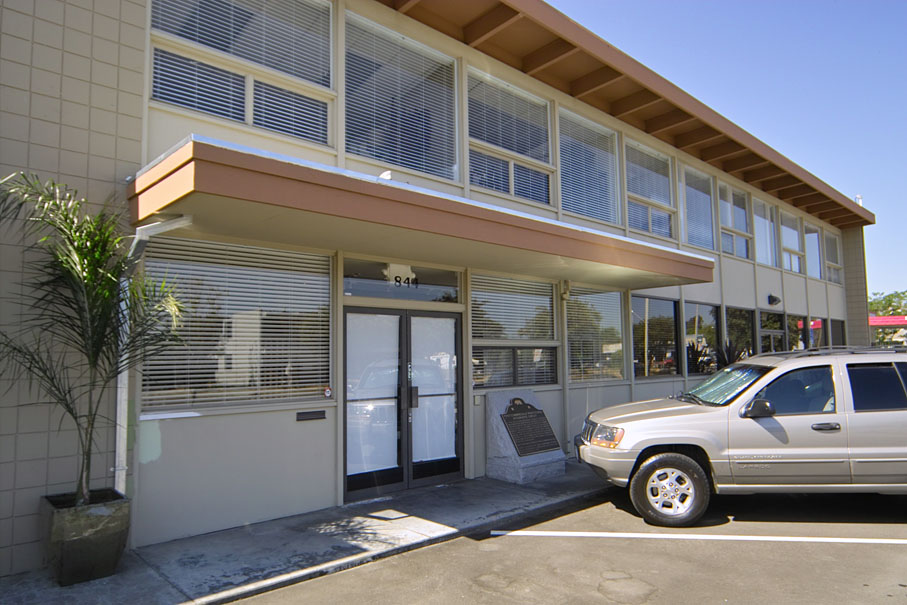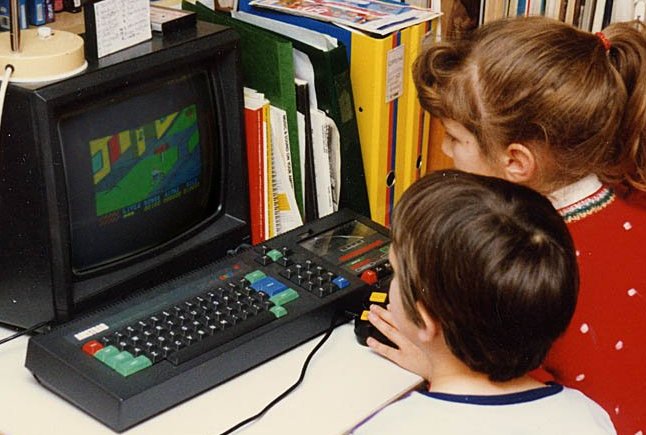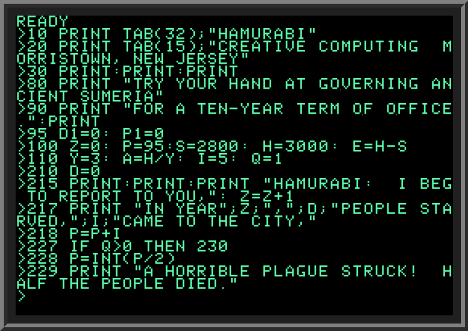|
APF Imagination Machine
The APF Imagination Machine is a combination home video game console and home computer system released by APF Electronics Inc. in late 1979. It has two separate components, the APF-M1000 game system, and an add-on docking station, docking bay with full sized typewriter keyboard and tape drive. The APF-M1000 was built specifically to compete with the Atari 2600. The full APF Imagination Machine, including the APF-M1000 console and the IM-1 computer component, originally sold for around (). Specifications *CPU: 8-bit 0.89 MHz Motorola 6800 (3.579 MHz Oscillator divided by 4) *Read-only memory, ROM: 14 KB *Random-access memory, RAM: 9 KB expandable to 17 KB (8 KB / 16 KB + 1 KB) *Video Display Controller: MC6847 *Resolutions: 256×192×4 / 128×192×8 *Colors: 8 *One sound channel in 5 octaves *Two controllers: **13 buttons ***0-9 numeric keypad ***Clear and End key ***Trigger **4-way joystick Overview APF Basic The bundled APF BASIC interpreter allows any users to develo ... [...More Info...] [...Related Items...] OR: [Wikipedia] [Google] [Baidu] |
MC6847
The MC6847 is a Video Display Generator (VDG) first introduced by Motorola in 1978 and used in the TRS-80 Color Computer, Dragon 32/64, Laser 200, TRS-80 MC-10/ Matra Alice, NEC PC-6000 series, Acorn Atom, Gakken Compact Vision TV Boy and the APF Imagination Machine, among others. It is a relatively simple display generator intended for NTSC television output: capable of displaying alphanumeric text, semigraphics, and raster graphics contained within a roughly square display matrix 256 pixels wide by 192 lines high. The ROM includes a 5 x 7 pixel font, compatible with 6-bit ASCII. Effects such as inverse video or colored text (green on dark green; orange on dark orange) are possible. The hardware palette is composed of twelve colors: black, green, yellow, blue, red, buff (almost-but-not-quite white), cyan, magenta, and orange (two extra colors, dark green and dark orange, are the ink colours for all alphanumeric text mode characters, and a light orange color is availab ... [...More Info...] [...Related Items...] OR: [Wikipedia] [Google] [Baidu] |
APF Electronics Inc
APF Electronics Inc. was a publicly traded company in the United States dedicated to consumer electronics. The company's name comes from the initials of the two brothers who founded the company, Al & Phil Friedman. History The company was founded to import stereos from Japan to the U.S., specifically quadraphonic sets and 8-track player. They moved into calculators. APF had locations in Queens, NY where they were headquartered, and in Hong Kong, where they owned a factory. In all, APF employed 300 people. Products APF marketed calculators in the early 1970s. Models such as the Mark III and Mark V had LED displays and used C batteries. APF TV Fun was a series of classic first generation video game consoles. It is one of the first system based on the common AY-3-8500 chipset from General Instrument. There are TV Fun Model 401A and TV Fun Sportsarama. The series was first available in 1976. APF-MP1000, also called M-1000, was a second generation video game console released in ... [...More Info...] [...Related Items...] OR: [Wikipedia] [Google] [Baidu] |
BASIC
Basic or BASIC may refer to: Science and technology * BASIC, a computer programming language * Basic (chemistry), having the properties of a base * Basic access authentication, in HTTP Entertainment * Basic (film), ''Basic'' (film), a 2003 film * Basic, one of the Galactic Basic, languages in ''Star Wars'' Music * Basic (Glen Campbell album), ''Basic'' (Glen Campbell album), 1978 * Basic (Robert Quine and Fred Maher album), ''Basic'' (Robert Quine and Fred Maher album), 1984 * B.A.S.I.C. (Alpinestars album), ''B.A.S.I.C.'' (Alpinestars album), 2000 * Basic (Brown Eyed Girls album), ''Basic'' (Brown Eyed Girls album), 2015 * B.A.S.I.C. (The Basics album), ''B.A.S.I.C.'' (The Basics album), 2019 Places * Basic, Mississippi, a community in the US * BASIC countries, Brazil, South Africa, India and China in climate change negotiations Organizations * BASIC Bank Limited, government owned bank in Bangladesh * Basic Books, an American publisher Other uses * Basic (cigarette), a brand ... [...More Info...] [...Related Items...] OR: [Wikipedia] [Google] [Baidu] |
Andy Grove
Andrew "Andy" Stephen Grove (born Gróf András István; 2 September 1936 – 21 March 2016) was a Hungarian-American businessman and engineer who served as the third CEO of Intel Corporation. He escaped from the Hungarian People's Republic during the 1956 revolution at the age of 20 and moved to the United States, where he finished his education. He was the third employee and eventual third CEO of Intel, transforming the company into the world's largest semiconductor company. As a result of his work at Intel, along with his books and professional articles, Grove had a considerable influence on electronics manufacturing industries worldwide. He has been called the "guy who drove the growth phase" of Silicon Valley. In 1997, ''Time'' magazine chose him as "Man of the Year", for being "the person most responsible for the amazing growth in the power and the innovative potential of microchips." One source notes that by his accomplishments at Intel alone, he "merits a place alongsi ... [...More Info...] [...Related Items...] OR: [Wikipedia] [Google] [Baidu] |
Input/output
In computing, input/output (I/O, i/o, or informally io or IO) is the communication between an information processing system, such as a computer, and the outside world, such as another computer system, peripherals, or a human operator. Inputs are the signals or data received by the system and outputs are the signals or data sent from it. The term can also be used as part of an action; to "perform I/O" is to perform an input or output operation. are the pieces of hardware used by a human (or other system) to communicate with a computer. For instance, a keyboard or computer mouse is an input device for a computer, while monitors and printers are output devices. Devices for communication between computers, such as modems and network cards, typically perform both input and output operations. Any interaction with the system by an interactor is an input and the reaction the system responds is called the output. The designation of a device as either input or output depend ... [...More Info...] [...Related Items...] OR: [Wikipedia] [Google] [Baidu] |
Fairchild Semiconductor
Fairchild Semiconductor International, Inc. was an American semiconductor company based in San Jose, California. It was founded in 1957 as a division of Fairchild Camera and Instrument by the " traitorous eight" who defected from Shockley Semiconductor Laboratory. It became a pioneer in the manufacturing of transistors and of integrated circuits. Schlumberger bought the firm in 1979 and sold it to National Semiconductor in 1987; Fairchild was spun off as an independent company again in 1997. In September 2016, Fairchild was acquired by ON Semiconductor. The company had locations in the United States at San Jose, California; San Rafael, California; South Portland, Maine; West Jordan, Utah; and Mountaintop, Pennsylvania. Outside the US, it operated locations in Australia; Singapore; Bucheon, South Korea; Penang, Malaysia; Suzhou, China; and Cebu, Philippines, among others. History 1950s In 1955, William Shockley founded Shockley Semiconductor Laboratory, funded by ... [...More Info...] [...Related Items...] OR: [Wikipedia] [Google] [Baidu] |
Home Computers
Home computers were a class of microcomputers that entered the market in 1977 and became common during the 1980s. They were marketed to consumers as affordable and accessible computers that, for the first time, were intended for the use of a single, non-technical user. These computers were a distinct market segment that typically cost much less than business, scientific, or engineering-oriented computers of the time, such as those running CP/M or the IBM PC, and were generally less powerful in terms of memory and expandability. However, a home computer often had better graphics and sound than contemporary business computers. Their most common uses were word processing, playing video games, and programming. Home computers were usually sold already manufactured in stylish metal or plastic enclosures. However, some home computers also came as commercial electronic kits, like the Sinclair ZX80, which were both home and home-built computers since the purchaser could assemble the u ... [...More Info...] [...Related Items...] OR: [Wikipedia] [Google] [Baidu] |
Apple II
Apple II ("apple Roman numerals, two", stylized as Apple ][) is a series of microcomputers manufactured by Apple Computer, Inc. from 1977 to 1993. The Apple II (original), original Apple II model, which gave the series its name, was designed by Steve Wozniak and was first sold on June 10, 1977. Its success led to it being followed by the Apple II Plus, Apple IIe, Apple IIc, and Apple IIc Plus, with the 1983 IIe being the most popular. The name is trademarked with square brackets as Apple ][, then, beginning with the IIe, as Apple //. The Apple II was a major advancement over its predecessor, the Apple I, in terms of ease of use, features, and expandability. It became one of several recognizable and successful computers throughout the 1980s, although this was mainly limited to the US. It was aggressively marketed through volume discounts and manufacturing arrangements to educational institutions, which made it the first computer in widespread use in American secondary ... [...More Info...] [...Related Items...] OR: [Wikipedia] [Google] [Baidu] |
Commodore PET
The Commodore PET is a line of personal computers produced starting in 1977 by Commodore International. A single all-in-one case combines a MOS Technology 6502 microprocessor, Commodore BASIC in read-only memory, keyboard, monochrome monitor, and, in early models, a cassette deck. Development of the system began in 1976, and it was demonstrated and sold as the first personal computer for the masses at the January 1977 Consumer Electronics Show. The name "PET" was suggested by Andre Souson after he saw the Pet Rock in Los Gatos, and stated they were going to make the "pet computer". It was backronymed to Personal Electronic Transactor. In a 1995 retrospective, ''Byte'' magazine—and subsequently many others—referred to the PET, Apple II and TRS-80 collectively as the "1977 trinity" of pioneering personal computers. Following the initial PET 2001, the design was updated through a series of models with more memory, better keyboard, larger screen, and other modifications. ... [...More Info...] [...Related Items...] OR: [Wikipedia] [Google] [Baidu] |
TRS-80
The TRS-80 Micro Computer System (TRS-80, later renamed the Model I to distinguish it from successors) is a desktop microcomputer developed by American company Tandy Corporation and sold through their Radio Shack stores. Launched in 1977, it is one of the earliest mass-produced and mass-marketed retail home computers. The name is an abbreviation of ''Tandy Radio Shack, Z80 [microprocessor]'', referring to its Zilog Z80 8-bit microprocessor. The TRS-80 has a full-stroke QWERTY keyboard, 4 kilobyte, KB dynamic random-access memory (DRAM) standard memory, small size and desk area, floating-point Level I BASIC language Interpreter (computing), interpreter in read-only memory (ROM), 64-character-per-line computer monitor, video monitor, and had a starting price of US$600 (equivalent to US$ in ). A cassette tape drive for program storage was included in the original package. While the software environment was stable, the cassette load/save process combined with keyboard bounce issues ... [...More Info...] [...Related Items...] OR: [Wikipedia] [Google] [Baidu] |
Atari
Atari () is a brand name that has been owned by several entities since its inception in 1972. It is currently owned by French holding company Atari SA (formerly Infogrames) and its focus is on "video games, consumer hardware, licensing and blockchain". The original Atari, Inc., founded in Sunnyvale, California, United States in 1972 by Nolan Bushnell and Ted Dabney, was a pioneer in arcade games, home video game consoles, and home computers. The company's products, such as '' Pong'' and the Atari 2600, helped define the electronic entertainment industry from the 1970s to the mid-1980s. In 1984, as a result of the video game crash of 1983, the assets of the home console and computer divisions of the original Atari Inc. were sold off to Jack Tramiel's Tramel Technology Ltd., which then renamed itself to Atari Corporation, while the remaining part of Atari, Inc. was renamed Atari Games Inc. In early 1985, Warner established a new corporation jointly with Namco subsequen ... [...More Info...] [...Related Items...] OR: [Wikipedia] [Google] [Baidu] |
BASIC Interpreter
A BASIC interpreter is an Interpreter (computing), interpreter that enables users to enter and run programs in the BASIC programming language, language and was, for the first part of the microcomputer era, the default Application software, application that computers would launch. Users were expected to use the BASIC interpreter to type-in programs, type in programs or to load programs from storage (initially cassette tapes then floppy disks). BASIC interpreters are of historical importance. Microsoft's first product for sale was a BASIC interpreter (Altair BASIC), which paved the way for the company's success. Before Altair BASIC, microcomputers were sold as kits that needed to be programmed in machine code (for instance, the Apple I). During the Altair period, BASIC interpreters were sold separately, becoming the first software sold to individuals rather than to organizations; Apple BASIC was Apple's first software product. After the Altair 8800, MITS Altair 8800, microcomputers w ... [...More Info...] [...Related Items...] OR: [Wikipedia] [Google] [Baidu] |






